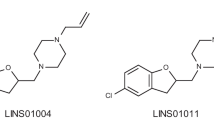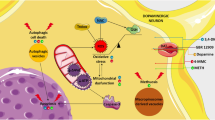Abstract
Purpose
The aim of this study was to evaluate the neurotoxicity of psychoactive abused 2,5-dimethoxy-substituted phenethylamines “2C series” in monoaminergic neurons.
Methods
After the exposure to “2C series”, 2,5-dimethoxy-4-propylthiophenethylamine (2C-T-7), 2,5-dimethoxy-4-isopropylthiophenethylamine (2C-T-4), 2,5-dimethoxy-4-ethylthiophenthylamine (2C-T-2), 2,5-dimethoxy-4-iodophenethylamine (2C-I) or 2,5-dimethoxy-4-chlorophenethylamine (2C-C), we examined their neurotoxicity, morphological changes, and effects of concomitant exposure to 3,4-methylenedioxymethamphetamine (MDMA) or methamphetamine (METH), using cultured neuronal dopaminergic CATH.a cells and serotonin-containing B65 cells.
Results
Single dose exposure to “2C series” for 24 h showed significant cytotoxicity as increase in lactate dehydrogenase (LDH) release from both monoaminergic neurons: 2C-T-7, 2C-C (EC50; 100 µM) > 2C-T-2 (150 µM), 2C-T-4 (200 µM) > 2C-I (250 µM) in CATH.a cells and 2C-T-7, 2C-I (150 µM) > 2C-T-2 (250 µM) > 2C-C, 2C-T-4 (300 µM) in B65 cells. The “2C series”-induced neurotoxicity in both cells was higher than that of MDMA or METH (EC50: ≥ 1–2 mM). In addition, apoptotic morphological changes were observed at relatively lower concentrations of “2C series”. The concomitant exposure to non-toxic dose of MDMA or METH synergistically enhanced 2C series drugs-induced LDH release and apoptotic changes in B65 cells, but to a lesser extent in CATH.a cells. In addition, the lower dose of 2C-T-7, 2C-T-2 or 2C-I promoted reactive oxygen species production in the mitochondria of B65 cells, even at the early stages (3 h) without apparent morphological changes.
Conclusion
The 2,5-dimethoxy-substitution of “2C series” induced severe neurotoxicity in both dopaminergic and serotonin-containing neurons. The non-toxic dose of MDMA or METH synergistically enhanced its neurotoxicity in serotonergic neurons.







Similar content being viewed by others
References
de Boer D, Bosman I (2004) A new trend in drugs-of-abuse; the 2C-series of phenethylamine designer drugs. Pharm World Sci 26:110–113. https://doi.org/10.1023/b:phar.0000018600.03664.36
Habrdova V, Peters FT, Theobald DS, Maurer HH (2005) Screening for and validated quantification of phenethylamine-type designer drugs and mescaline in human blood plasma by gas chromatography/mass spectrometry. J Mass Spectrom 40:785–795. https://doi.org/10.1002/jms.853
King LA (2014) New phenethylamines in Europe. Drug Test Anal 6:808–818. https://doi.org/10.1002/dta.1570
Meyer MR, Maurer HH (2010) Metabolism of designer drugs of abuse: an updated review. Curr Drug Metab 11:468–482. https://doi.org/10.2174/138920010791526042
Theobald DS, Fehn S, Maurer HH (2005) New designer drug, 2,5-dimethoxy-4-propylthio-beta-phenethylamine (2C-T-7): studies on its metabolism and toxicological detection in rat urine using gas chromatography/mass spectrometry. J Mass Spectrom 40:105–116. https://doi.org/10.1002/jms.784
Kanamori T, Kuwayama K, Tsujikawa K, Miyaguchi H, Iwata YT, Inoue H, Kishi T (2007) In vivo metabolism of 2,5-dimethoxy-4-propylthiophenethylamine in rat. Xenobiotica 37:679–692. https://doi.org/10.1080/00498250701329302
Boatto G, Nieddu M, Dessi G, Manconi P, Cerri R (2007) Determination of four thiophenethylamine designer drugs (2C-T-series) in human plasma by capillary electrophoresis with mass spectrometry detection. J Chromatogr A 1159:198–202. https://doi.org/10.1016/j.chroma.2006.10.051
Nieddu M, Boatto G, Pirisi MA, Dessi G (2010) Determination of four thiophenethylamine designer drugs (2C-T-4, 2C-T-8, 2C-T-13, 2C-T-17) in human urine by capillary electrophoresis/mass spectrometry. Rapid Commun Mass Spectrom 24:2357–2362. https://doi.org/10.1002/rcm.4656
Lin LC, Liu JT, Chou SH, Lin CH (2003) Identification of 2,5-dimethoxy-4-ethylthiophenethylamine and its metabolites in the urine of rats by gas chromatography-mass spectrometry. J Chromatogr B Analyt Technol Biomed Life Sci 798:241–247. https://doi.org/10.1016/j.jchromb.2003.09.052
Chiu YC, Chou SH, Liu JT, Lin CH (2004) The bioactivity of 2,5-dimethoxy-4-ethylthiophenethylamine (2C-T-2) and its detection in rat urine by capillary electrophoresis combined with an on-line sample concentration technique. J Chromatogr B Analyt Technol Biomed Life Sci 811:127–133. https://doi.org/10.1016/j.jchromb.2004.08.021
Theobald DS, Staack RF, Puetz M, Maurer HH (2005) New designer drug 2,5-dimethoxy-4-ethylthio-beta-phenethylamine (2C-T-2): studies on its metabolism and toxicological detection in rat urine using gas chromatography/mass spectrometry. J Mass Spectrom 40:1157–1172. https://doi.org/10.1002/jms.890
Theobald DS, Putz M, Schneider E, Maurer HH (2006) New designer drug 4-iodo-2,5-dimethoxy-beta-phenethylamine (2C-I): studies on its metabolism and toxicological detection in rat urine using gas chromatographic/mass spectrometric and capillary electrophoretic/mass spectrometric techniques. J Mass Spectrom 41:872–886. https://doi.org/10.1002/jms.1045
Kanamori T, Kuwayama K, Tsujikawa K, Miyaguchi H, Iwata YT, Inoue H (2011) Synthesis and identification of urinary metabolites of 4-iodo-2,5-dimethoxyphenethylamine. J Forensic Sci 56:1319–1323. https://doi.org/10.1111/j.1556-4029.2011.01809.x
Bosak A, LoVecchio F, Levine M (2013) Recurrent seizures and serotonin syndrome following “2C-I” ingestion. J Med Toxicol 9:196–198. https://doi.org/10.1007/s13181-013-0287-x
Eshleman AJ, Forster MJ, Wolfrum KM, Johnson RA, Janowsky A, Gatch MB (2014) Behavioral and neurochemical pharmacology of six psychoactive substituted phenethylamines: mouse locomotion, rat drug discrimination and in vitro receptor and transporter binding and function. Psychopharmacology 231:875–888. https://doi.org/10.1007/s00213-013-3303-6
Miyazaki I, Asanuma M, Diaz-Corrales FJ, Fukuda M, Kitaichi K, Miyoshi K, Ogawa N (2006) Methamphetamine-induced dopaminergic neurotoxicity is regulated by quinone-formation-related molecules. FASEB J 20:571–573. https://doi.org/10.1096/fj.05-4996fje
Asanuma M, Nishibayashi-Asanuma S, Miyazaki I, Kohno M, Ogawa N (2001) Neuroprotective effects of non-steroidal anti-inflammatory drugs by direct scavenging of nitric oxide radicals. J Neurochem 76:1895–1904. https://doi.org/10.1046/j.1471-4159.2001.00205.x
Nagai F, Nonaka R, Satoh Hisashi Kamimura K (2007) The effects of non-medically used psychoactive drugs on monoamine neurotransmission in rat brain. Eur J Pharmacol 559:132–137. https://doi.org/10.1016/j.ejphar.2006.11.075
Rickli A, Luethi D, Reinisch J, Buchy D, Hoener MC, Liechti ME (2015) Receptor interaction profiles of novel N-2-methoxybenzyl (NBOMe) derivatives of 2,5-dimethoxy-substituted phenethylamines (2C drugs). Neuropharmacology 99:546–553. https://doi.org/10.1016/j.neuropharm.2015.08.034
Curtis B, Kemp P, Harty L, Choi C, Christensen D (2003) Postmortem identification and quantitation of 2,5-dimethoxy-4-n-propylthiophenethylamine using GC-MSD and GC-NPD. J Anal Toxicol 27:493–498. https://doi.org/10.1093/jat/27.7.493
Rohanova M, Palenicek T, Balikova M (2008) Disposition of 4-bromo-2,5-dimethoxyphenethylamine (2C-B) and its metabolite 4-bromo-2-hydroxy-5-methoxyphenethylamine in rats after subcutaneous administration. Toxicol Lett 178:29–36. https://doi.org/10.1016/j.toxlet.2008.01.017
Acknowledgements
This work was supported by Health and Labour Sciences Research Grants for Research on Regulatory Science of Pharmaceuticals and Medical Devices (to M.A., M.F.) from the Japanese Ministry of Health, Labour and Welfare, and by a Research Grant from the Okayama Medical Foundation (to I.M.).
Author information
Authors and Affiliations
Corresponding author
Ethics declarations
Conflict of interest
The authors declare that they have no conflict of interest.
Ethical approval
This article does not contain any studies with human participants performed by any of the authors.
Additional information
Publisher's Note
Springer Nature remains neutral with regard to jurisdictional claims in published maps and institutional affiliations.
Electronic supplementary material
Below is the link to the electronic supplementary material.
Rights and permissions
About this article
Cite this article
Asanuma, M., Miyazaki, I. & Funada, M. The neurotoxicity of psychoactive phenethylamines “2C series” in cultured monoaminergic neuronal cell lines. Forensic Toxicol 38, 394–408 (2020). https://doi.org/10.1007/s11419-020-00527-w
Received:
Accepted:
Published:
Issue Date:
DOI: https://doi.org/10.1007/s11419-020-00527-w




